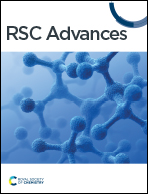Characterization and antibacterial behavior of an edible konjac glucomannan/soluble black tea powder hybrid film with ultraviolet absorption
Abstract
In this study, a KGM/SBTP film was prepared by a blending method using KGM and a soluble black tea film (SBTP) as substrates, and its hygroscopicity, thermal properties, light barrier properties, microstructure, and bacteriostatic properties were evaluated. The results confirmed that compared with the control group, with the increase in the SBTP content, the transmittance of the film in the ultraviolet region significantly reduced, and the water barrier property and thermal stability were improved. Fourier transform infrared spectroscopy (FTIR) and scanning electron microscopy (SEM) results indicated that the tea polyphenols interacted with the film substrate. SEM also showed that the structure of the KGM/SBTP films was smooth and flat, and all samples showed no fracture. In addition, the KGM/SBTP mixed membrane had obvious concentration-dependent antibacterial activity. When the concentration of SBTP was 0.9%, the inhibition zones against Staphylococcus aureus and Escherichia coli were 12.30 ± 0.20 mm and 12.05 ± 0.47 mm, respectively.



 Please wait while we load your content...
Please wait while we load your content...